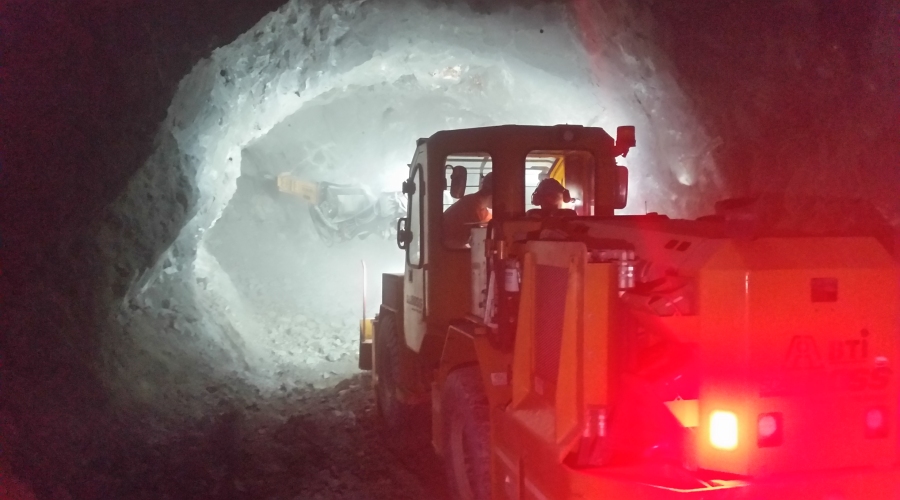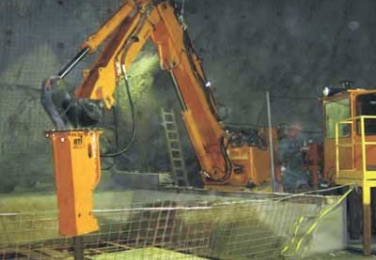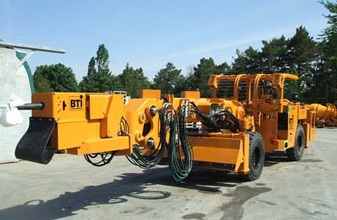
When it comes to large, unwieldy rocks, mines and quarries deploy rockbreakers, which can be visualized as the big guns that serve as a kind of first assault in the ground war between rock and machine.
After ore is blasted loose from the host rock, it comes in a variety of shapes and sizes, never uniform. Surface operations typically employ jaw crushers or gyratory crushers, where material is brought to the crusher by large haul trucks and dumped into a rock box.
Underground operations don’t have the space for large crushers, so they typically use a steel grate called a grizzly to size material before it enters an ore pass. Material that is too large cannot pass through the openings in the grizzly and are left to be broken by a rockbreaker, while the smaller material is allowed to pass through the grizzly down the ore pass.
Stationary rockbreakers: the heart of the operation

Stationary rockbreakers work in conjunction with a grizzly, which sizes material before it enters the ore pass.
The ore chunks that are too large to go through the grizzly are piled next to, or on top of the grizzly, where excavators equipped with a hydraulic hammer break them down. Other mines choose to employ a stationary boom that can move the rocks around and break them so they can fall through the grizzly grates.
The boom chosen to carry the selected breaker depends on its ability to provide full coverage of the area where material will require breaking, racking or clearing. The choice also depends on ore size, the production rate the mine wants to achieve, and rock hardness. The most powerful breakers will be used to break the hardest rock, such as iron ore or granite, while less-powerful breakers will be needed to bust medium-hardness rock like limestone or dolomite, or soft minerals like talc, slate or asbestos.
BTI, an Ontario-based manufacturer of rockbreaker systems – including stationary and mobile rockbreakers, hydraulic breakers, attachments and mobile equipment – offers hydraulic breakers in its BX Series that range from 400 to 4,000 foot-pounds.
“It’s more of an art than a science. Whatever information is available we try to size the rig. Typically we go one size up, to be on the safe side,” says Indika (Indy) Balasuriya, product engineer with BTI specializing in rockbreaker systems.
According to Balasuriya, mine operators are looking for reliability in their rockbreakers – like all mining equipment downtime cost money – as well as a smooth operation of the boom both for productivity and operator comfort.
About 20 to 30 percent of stationary rockbreakers are remote-controlled, useful for breaking rocks outside the sight range of the operator’s cabin; the remotes have a range of between 300 and 1,000 feet.
Right now BTI offers automation on some of its stationary rockbreaker models, including sensors on the boom that can control its position, program the boom to avoid hitting structures, and do automated movements like tell the boom to go to a certain position at the beginning of the shift and end the shift at a park position.
Balasuriya said the next step will be to fine-tune the technology and combine it with surface mapping, thus enabling the rockbreaker to identify which rocks on the pile need to be broken, and then send a signal to the boom to break them.
Mobile rockbreakers, scalers and MPVs

BTI’s Hammer Feed Scaler.
Sometimes a mine wants the flexibility of being able to break rock at multiple grizzlies underground. In these cases, the mine operator would likely choose a mobile rockbreaker. The rubber-tired vehicles, equipped with a boom and hydraulic breaker, perform the same functions as their stationary counterparts, but with the advantage of mobility.
BTI offers two mobile rockbreaker models, the TM12 and the TM15. Like stationary rockbreakers, ore size, production rate and rock hardness will determine which machine to use and what size breaker to employ.
“For the very hardest like granite and trap rock we can go up to as high as 50,000 PSI material with an 8,500 foot-pound breaker, which would be on our TM-15X model,” says Andy Jackson, BTI’s mobile equipment product specialist. “You could have some pretty big chunks for using that breaker, but our most popular size is a 3,000 foot-pound breaker which is in that 25,000 to 30,000 PSI rock range.”
Another piece of rockbreaking equipment commonly seen underground is a scaler, used to remove loose chunks of rock that could fall on miners or damage equipment. Some mine operators avoid mechanical scaling because it interrupts their production cycle, others choose to scale voluntarily for safety, while some mines, such as those in South America, are required by legislation to do it.
A hammer feed scaler (HFS) has a cylinder in the breaker head that feeds the breaker, rather than the telescopic section of the boom. This allows the hammer feed scaler to apply lesser force to the rock needing to be removed.
“It’s more of an art than a science. Whatever information is available we try to size the rig. Typically we go one size up, to be on the safe side”: Indy Balasuriya, product engineer with BTI specializing in rockbreaker systems
“Scaling is not like mining. You don’t want take a lot of material down, so, with a small breaker, if you get a really big boom behind it, you can really damage the breaker if you’re using the high force of the telescopic function. So, there are interlocks in there that don’t allow you to use the breaker unless you’re feeding it with that small cylinder and not the others,” Jackson explained. He noted the hammer feed scaler is the oldest of BTI’s scaler offerings, with a lot of HFS models sold to mines in Brazil and Peru.
Vibratory pick scalers are used for softer materials like limestone, salt and gypsum. A cylinder induces force into the pick tooth, which causes a lot of wear on the body of the machine, and the operator too. To deal with that problem, BTI designed a hydraulic breaker into the back of the pick.
“You’re just not using brute force to break down the material, you’re actually vibrating it loose, too, so that way, it transmits less energy back into the machine,” says Jackson. “You typically see less maintenance on the machine, and it’s also a little more comfortable for the operator.”
BTI’s most recent scaler offering is the ScaleBOSS 3D Scaler, which is a compact machine meant for low galleries 3 to 5-metres high.
“It’s also on a brand new platform that’s got superior ergonomics and visibility to our other machines,” Jackson describes. “It’s got hydraulic wheel drive which is basically a state-of-the-art hyperstatic system that allows for higher efficiencies, so it allows us to have equal speed on grade with less horsepower than similar vehicles of the same gross vehicle weight.”
Other technological goodies: the ScaleBOSS is electronically controlled and programmed, with diagnostics capabilities, and it has a control for manipulating the breaker’s swing and tilt that is “basically like a human wrist,” says Jackson. The same feature is available on BTI’s RMS18 scaler model.
Getting machinery underground and powered up can be a challenge, but that’s where multi-purpose vehicle systems come in handy. MPVs employ a dedicated power unit which can be used to power a number of pieces of equipment, or “cassettes” on the back of the vehicle, such as a shotcrete remixer, personnel carrier or crane. The cassettes can be hooked up or removed within minutes, allowing for a high degree of interoperability.
“They’re also very popular at the mine development stage,” notes Jackson. “It allows them to keep capital equipment costs down at the beginning by utilizing one power unit to do a number of different utility functions.”
Another recent underground equipment offering from BTI is the Mine Runner. Resembling a more robust version of a Toyota Land Cruiser, the Mine Runner lends itself well to hauling personnel and small loads, such as spare tires or drill bits. The Mine Runner has a higher payload than a Toyota Land Cruiser and it’s also more maneuverable, with a tighter turning radius.
“We’re hoping for it to be a smaller, less expensive option for utilities,” Jackson said.